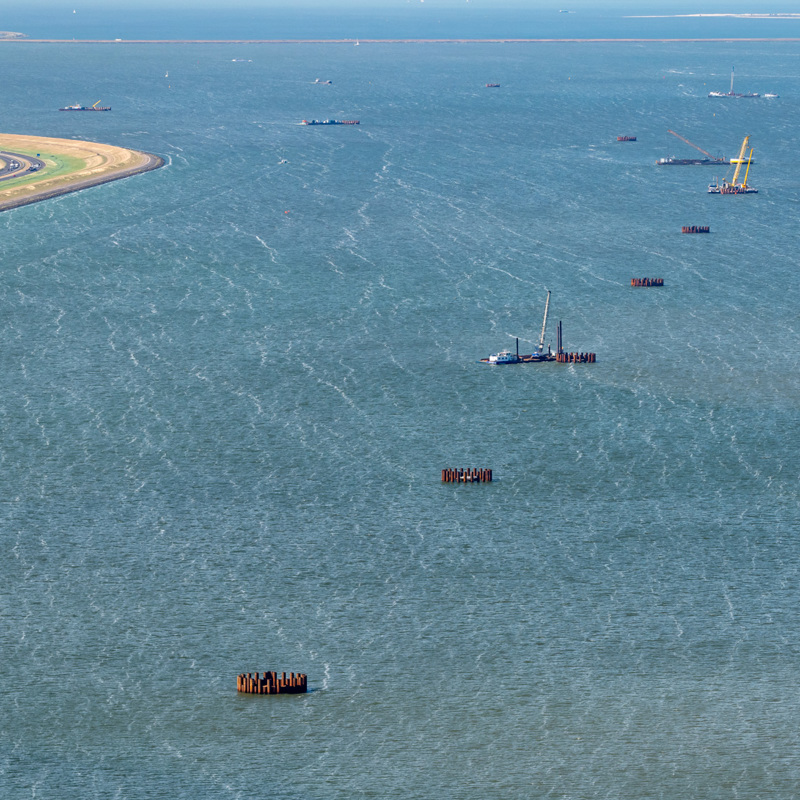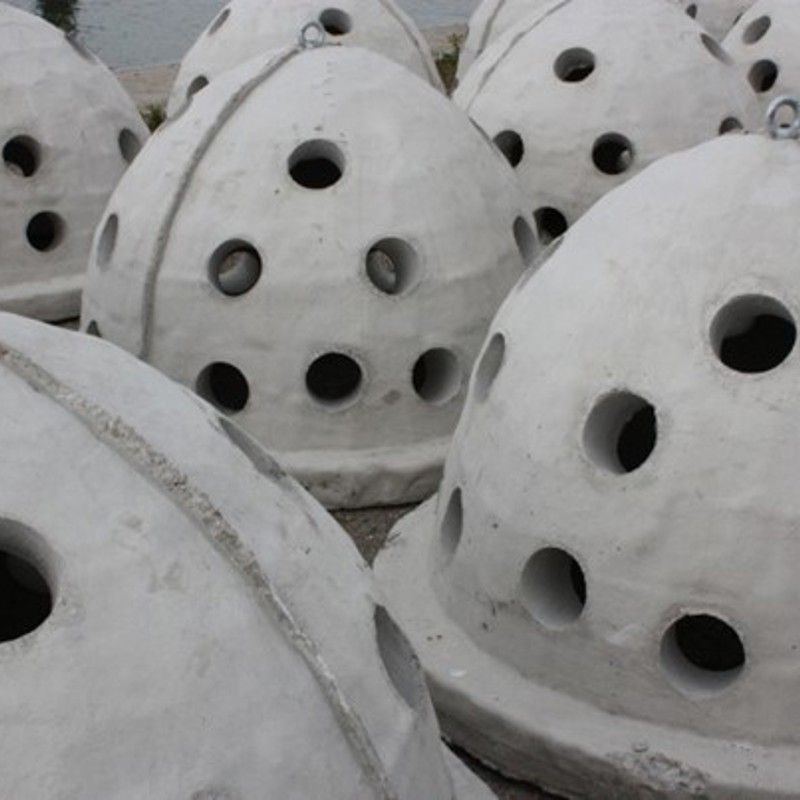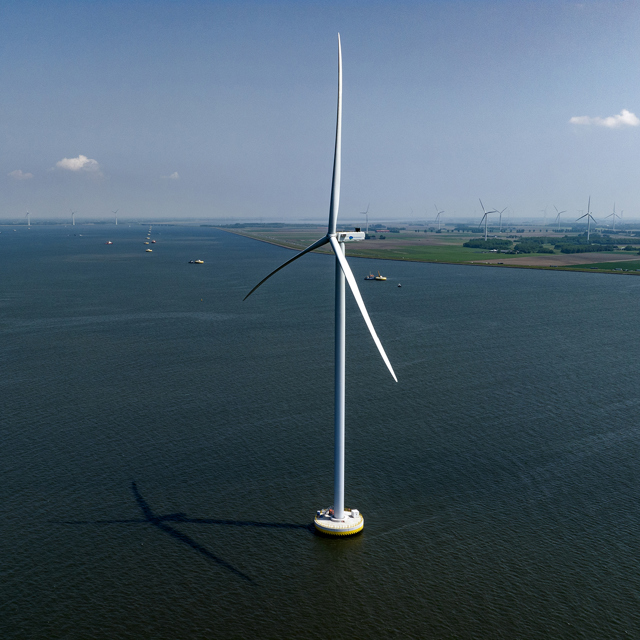Lessons learned and ecological measures at Windplanblauw
In the IJsselmeer, northeast of Lelystad, Ballast Nedam has helped install 24 new wind turbines. They are part of project Windplanblauw, the wind park that makes an important contribution to the energy transition in the province of Flevoland. What did working on this special, ‘nearshore’ Natura 2000 site entail? And what ecological measures were involved?
These new turbines each generate 6 megawatts of power - ten times more than the old ones - with a combined capacity of 132MW. They belong to Windplanblauw, a wind farm by energy company Vattenfall and the farmers’ cooperative SwifterwinT. Just like a quarter of a century ago, Ballast Nedam is involved in this project. This time with the design and construction of the new turbine foundations, the park cabling and the connection to the feed station several kilometres away.
Land turbines on water
The new wind turbines are 100 to 500 metres away from the banks of the IJsselmeer. “We call that a nearshore location”, explains business developer Jan de Vries. “There is offshore, far out to sea, and onshore, on land. This is in between.” In cooperation with the client, Ballast Nedam devised a special solution to install the turbines on this specific soil. Ultimately, the choice fell on land turbines, which were placed in the water using round islands of concrete as foundations.
This entailed a specific situation, as project manager Roy Hopmans knows: “The solution was very much like a land foundation, intended for land turbines. That is why we mainly used land contractors. But in the end, it all happened on water. Everyone had to get used to that. On land, if you forget to bring something, you walk back to your van to get it. Now, you had to think carefully before you all got on the boat to the construction site. Because if you forget something, it takes a couple of hours. That is a great learning opportunity. So, it's a matter of preparing a bit more thoroughly.”
Turning wind
Another circumstance, typical of the IJsselmeer: turning wind directions. “As soon as the wind turns, the waves come from a different direction. The IJsselmeer is shallow and therefore extra sensitive to this phenomenon. This regularly meant that we had to break up suddenly halfway through the day because we could no longer continue working because of the waves. We took this into account in the planning, so we could be flexible with it and still stay on schedule.”
Reef balls and bird grids
The offshore location of Windplanblauw is in a Natura 2000 site. That means it falls under European bird and habitat directives, which protect biodiversity. Jan: “For us, this meant that we had to comply with specific requirements. These derive from the permit the client had received, which included the conditions you have to meet from the Natura 2000 rules. In short, you have to compensate for the paved elements you place in the area and take measures to protect fauna and the environment.” Ballast Nedam itself also aims to have as little impact as possible on the surroundings of a construction site. “So, the motivation to do the right things here was two-sided”, according to Roy. This led to a number of ecological measures.
For instance, about 200 reef balls were placed on the bottom of the lake. These are artificial reef structures of about a metre high, shaped like a church bell. Made of eco-friendly pH-neutral concrete, they provide a habitat for marine organisms. These are eaten by fish, which turn into food for birds. Thus, the reef balls give a positive boost to the food chain in the area. During the construction phase, birds were also protected, through bird grids. These were placed on the open ends of the piles to prevent birds from getting trapped inside the piles.
Fish were also considered, using the time-honoured method of 'ditch filling'. Roy: “We filled the water-filled building pits with sand bit by bit. This allowed the fish swimming around in them to escape before we had completely filled the foundation.” Other special ecological measures included installing raised edges on the pontoons (to prevent any liquid pollution from flowing into the lake), the use of biodegradable oil and a special lighting plan, where construction lights only shone on the work to minimise light pollution and not disturb the surrounding nature and environment.


The human component
Carrying out work with all these ecological measures also brings human challenges. “The human component does come into play”, Roy replies. “You have to make all employees on the project realise that it is important, so that everyone goes along with it. When pouring concrete, for example, you don't want the last bit to run over something and end up in the water. So, you have to catch that with a bucket and then take it away. That is an extra effort, which can be quite demanding after 12 hours of pouring concrete. Still, it has to be done.”
Sustainable construction, clean energy
Roy is happy with all the ecological measures taken around the construction of Windplanblauw. “I personally think this is important. It should be normal procedure in projects to make as little impact on the environment as possible, especially on a site like this.” Jan sees that Dutch companies are at the forefront when it comes to sustainable construction. “In our country, we run up against limits in all sorts of ways, so we are challenged to think about this more and more. What we learn from that, we can apply everywhere.”
Does this mean Ballast Nedam is a good partner for the realisation of subsequent wind farms? “Especially when it comes to smaller farms, in nearshore locations with specific conditions. We are now set to take extra steps. And in projects like Windplanblauw, we have of course gained all kinds of specific knowledge again and learned our lessons. These come in handy in every subsequent project.” In this way, we contribute to the energy transition by generating cleaner energy. At the same time, we considered the sustainability of the environment during construction and were able to take appropriate ecological measures to protect nature, even under water.





